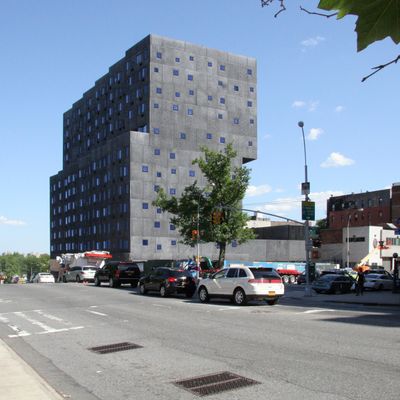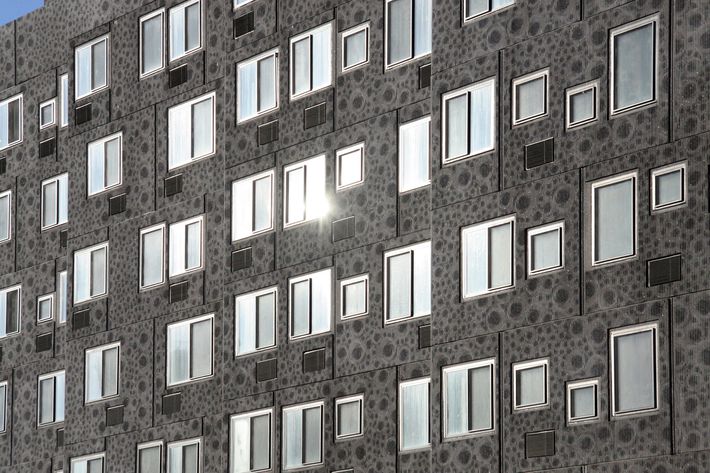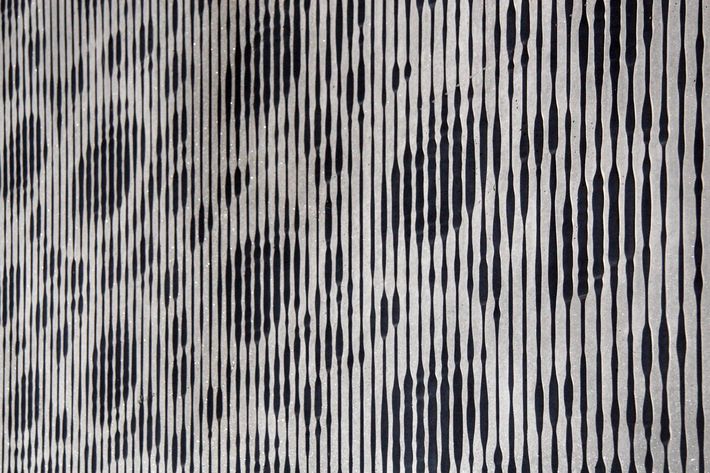
If the Bronx ever invaded Harlem, surging over the Macombs Dam Bridge from Yankee Stadium, its forces might hesitate at the sight of Sugar Hill, the apartment complex designed by David Adjaye. The medieval-looking structure at the corner of 155th Street and St. Nicholas Avenue looms like a ruined bastion at the crest of Coogan’s Bluff, a pair of great squared-off boulders stacked slightly askew, as if a defending army had readied it for toppling. The west façade is pitted with small square windows that glint like mica in the granitic mass.

It’s a hard to fathom why Adjaye would evoke a hilltop citadel, or clad it in storm-cloud-colored concrete so that even on a perfect June day it glowers forbiddingly against the sky — after all, the building’s intentions are exactly opposite. This castle is a home — 124 of them actually, developed by the nonprofit Broadway Housing Communities to provide a struggling neighborhood with desperately needed affordable housing. Below the apartments are two institutions geared to kids: an early childhood center and a children’s museum, separated by a narrow court. The whole thing will rest on a foundation of giggles and squeals, a fact that will invigorate some residents and irritate others, but surely represents a boon in an area desperate for such facilities. Adjaye rightly rejects the brick box model of public housing and public schools. Why, then, replace it with a dead-eyed guard tower?
It’s a shame that Sugar Hill turned out so grim, because in every other way it’s a model for the kind of high-design, low-cost housing that the city needs. For one thing, it’s an impressively pleasant place to live. The St. Nicholas Avenue façade is broken into a series of bays and accorded more generous windows, so the modest apartments are rich in light and views. From inside, you can’t mistake your place in the world, since you can glance up from the breakfast table and see the midtown skyline, Yankee Stadium, or various swaths of park that pinwheel away in all directions. From the roof — which may one day be gardened but for now is merely graveled — you can scan the horizon from Riverdale to the Battery. The school’s glass walls look out on 155th Street, which drops precipitously away, giving children the feeling of loftiness even without climbing a single floor. The Children’s Museum of Art and Storytelling is far more than a community art center: It’s a high-ceilinged, 15,000-square-foot suite of galleries with state-of-the-art lighting and sound. It also contains one of those unexpectedly beautiful throwaway spaces that have given Adjaye his international reputation: a tall and narrow hallway, flooded by sunshine that drops in through a startling skylight.
Pleasantness has a historical dimension, here. The Sugar Hill neighborhood was the center of the sweet life during the Harlem Renaissance, the mythic destination in the Ellington/Strayhorn standard “Take the A Train.” Langston Hughes, in a 1944 essay in The New Republic, described these heights as the peak of black bourgeois aspiration: “It is, I should imagine, nice to be smart enough and lucky enough to be among Dr. Dubois’ ‘talented tenth’ and be a race leader and go to the symphony concerts and live on that attractive rise of bluff and parkway along upper Edgecombe Avenue overlooking the Polo Grounds, where the plumbing really works and the ceilings are high and airy.”
The neighborhood’s architectural standards are lofty, too, and Adjaye, a careful and thorough documenter of context and precedent, has produced a mash-up of local references. The medieval look nods to the surrounding blocks of gracious neo-Gothic buildings, and perhaps to High Bridge Tower over on the next ridge. When afternoon sunshine rakes across it, Sugar Hill’s gray façade springs to life, bringing out corrugations and tactile patterns. Furrows cut in the concrete panels widen and narrow like miniature canyons or magnified grooves in a vinyl record. It would be tempting to drop an obelisk-size needle onto that surface and see what kind of music it makes — a slowed-down, rumbling “Take the A Train,” maybe. Step back, and those irregularities resolve into a relief of stylized roses — an abstract, ghosted version of the hand-tooled thistles and ornamental vines that adorn brownstones and cornices all over the neighborhood. (The floral pattern does double duty, paying homage to the recently established Heritage Rose District, which has made the area around Trinity Cemetery bloom with pedigreed roses.) But Adjaye is invoking a tradition that doesn’t flatter his contribution. Those old botanical carvings dressed up the streets with hyperbolically detailed workmanship, making the ordinary seem fantastical. By comparison, his digitally drawn roses, twining around cheap air conditioning units, seem crude, the product of an evening spent fiddling with Photoshop.

Sugar Hill is maddening precisely because of its fine intentions, both social and artistic. Funded by a variety pack of public agencies and grants, and overseen by a passel of bureaucracies, the process took far longer than it should, making it a warning light for Mayor de Blasio’s accelerated affordable housing drive. The budget climbed along the way, but not outrageously — and not because of any celebrity architect premium. A cantilevered complex with a museum in the basement runs more than a plain brown box, and even so, construction cost $276 per square foot, which includes the expense of building on such a steep and jagged site, cleaning up the pollution from an old gas station, and upgrading the neighborhood’s inadequate electrical system. Sugar Hill was conceived as a showcase, an example of how world-class architecture can elevate affordable housing. That’s a lesson that needs proclaiming and bears repeating — but not by a design that hobbles worthy ambitions with extravagant misjudgment.






























